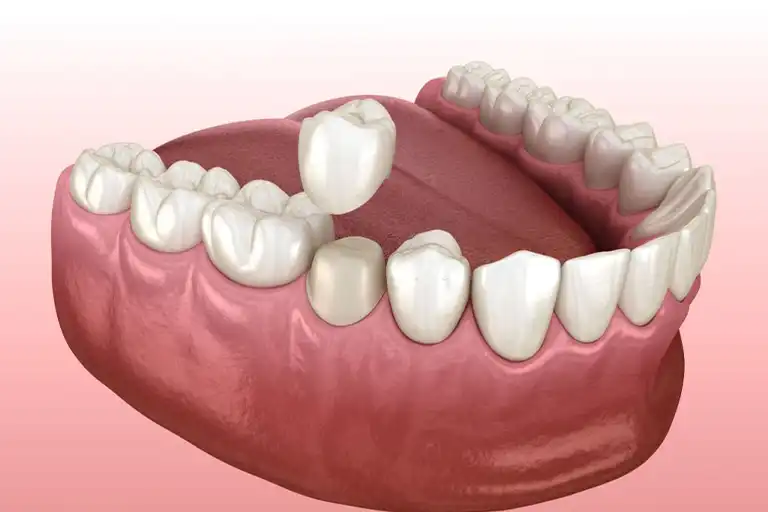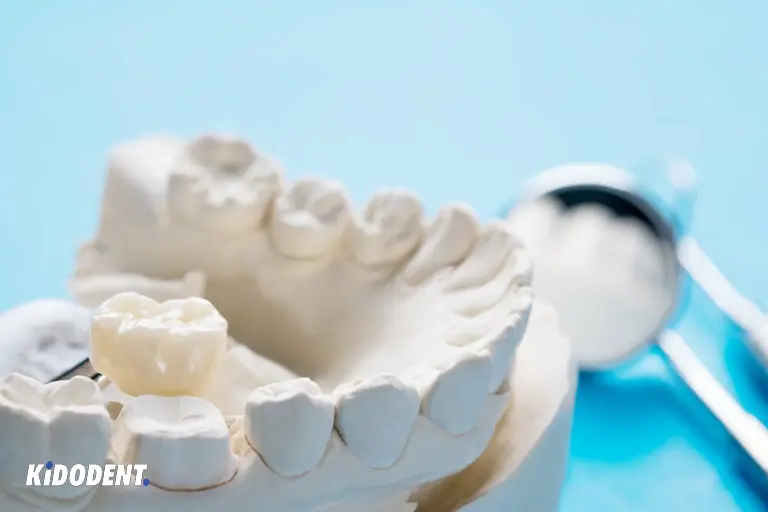It usually takes a few weeks for a dental lab to construct a custom-made permanent crown—except for the CEREC crowns which are made in a couple of hours. In the meantime, a dentist fits a temporary crown. This is to provide your tooth and gums protection and give you the normal function of chewing or speaking. In this article, you will learn about temporary dental crowns, their use, how your dental professional makes them, and how best to care for them once you get one.
What is a temporary crown?
A temporary crown is a tooth-shaped cap that protects your prepared natural tooth or an implant until your permanent crown is made and placed.
Temporary crowns are cemented into place by temporary cement, zinc oxide– eugenol composition. This will allow the dentist to remove it more easily later.
What is a temporary crown made of?
Temporary crowns are made of acrylic or composite. Both these materials are available in different shades to match the color of your teeth.
When is a temporary crown needed?
Dental crowns are caps to restore and protect a tooth that is seriously damaged. You will likely need a dental crown if your teeth are weak, decayed, or worn out. They also offer a great cosmetic solution for discolored or misshapen teeth. Dentists also use crowns to secure dental bridges, cover a dental implant, and when you have undergone a root canal treatment.
To prepare your permanent crown, your dentist needs to first reshape and remove your tooth to make space for the crown. Then your dentist takes an impression of the tooth and sends it to the dental laboratory where your custom-sized crown is made. It may take 2 to 3 weeks for your permanent crown to be made. Therefore, you will need a temporary crown to be placed over your tooth during this time span.
Here are some reasons why a temporary crown is needed:
- To cover and protect your natural tooth and the gum tissues while the crown is being made, or the implant site until it heals
- To prevent possible tooth or gum sensitivity
- Maintaining the space and the contact between the adjacent teeth
- Allowing you to eat and chew normally
- Help you smile without fearing of any gaps
How long do you keep a temporary crown?
Normally, you need to have your temporary dental crown in place for 2 to 3 weeks. It can take more depending on when your dental professional fabricates and places the permanent one.
Dental implants, however, need more time before the permanent crown placement. The bone and the gum of the implant site take several weeks to months to heal, so you should expect a longer time for the temporary crown to stay in place.

What is the procedure like for a temporary dental crown?
One thing to remember is that you only need a temporary crown for the conventional permanent crown fabrication, requiring 2 to 3 weeks for the lab to prepare the permanent crown. You will not need one if you are getting a CEREC same-day crown, which can be made and placed in one single appointment. Therefore, you will have two dental visits for your dental crown procedure in the traditional way.
First appointment
- Take X-rays and do other necessary examinations on the tooth receiving the crown. Your dentist may need to perform a root canal, which means a third dental visit.
- Make an impression of the teeth to get an original model.
- Apply anesthesia to numb your tooth and then preparing it. Your dentist files down the tooth from the top and sides until there is enough room for a crown to fit.
- Take an impression of the prepared tooth and other teeth to send it to the lab to fabricate the permanent crown.
- Your dentist creates and places your temporary crown, which you will keep on until your permanent crown is made.
Here are the steps for making your temporary dental crown. This process can take 10-15 minutes.
- Prior to tooth preparation, your dentist takes an impression of the tooth and the surrounding teeth. A stone model (diagnostic wax-up) of your teeth is first created, which is used for the fabrication of the matrix or the impression model.
- After preparing the tooth, the temporary crown material is squirted into the impression and onto the prepared tooth.
- The impression is placed on the tooth. When the temporary material is set, your dentist removes the impression and the hardened crown from over the tooth.
- The temporary crown is trimmed and polished.
- Your dentist cements the temporary crown in place.
Second appointment
- Your dentist will remove the temporary crown using a special dental tool to break the seal of the adhesive and gently pop the crown off around the tooth.
- Your dentist fits the permanent crown in its place.
How do you care for temporary crowns?
A temporary crown, as its name, is meant to serve for a short-term period. They may resist normal pressure or force but they are not as strong material as you would expect from permanent ones. Plus, the type of cement is weaker for their bonding. This should make it easier for a dentist to remove it. With that said, they need extra care and attention.
Here are some care tips to remember:
- After you get your temporary crown, avoid eating or drinking for 30 minutes.
- Brush your teeth gently and use a soft-bristled toothbrush.
- Be careful while flossing so that you don’t pull off or dislodge the crown. Floss gently and try sliding the floss with in and out motion.
- Avoid eating hard and sticky foods. Stay away from foods that are tough, crunchy, and sugary, as well as those that can easily get stuck between the crown and your teeth.
- Avoid very hot and cold foods and drinks. This is to prevent sensitivity in the tooth underneath as the crown may not seal over it as it should and the fact that extreme temperature may affect the cement or weaken your crown.
You may feel some mild pain and discomfort for the first few days after you receive the crown. However, you should contact your dentist if your pain lasts longer or you have throbbing pain—the pain that is strong and persistent— as this might be a sign of infection or decay of the tooth.
What to do if a temporary crown comes off?
If your temporary crown comes off, call your dentist and schedule a dental appointment ASAP. If it is intact and still in good shape, your dentist will simply recement it back.
In case the crown cracks, fractures, or is lost, your dentist will make you a new one in a simple and quick procedure.
